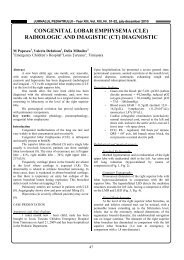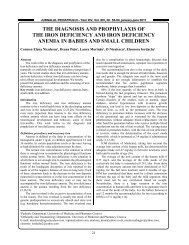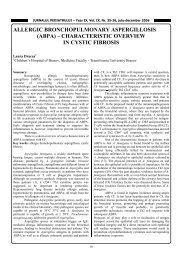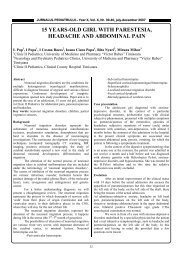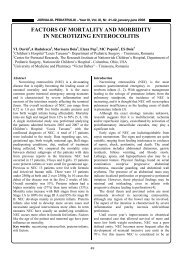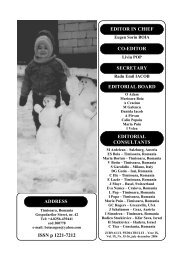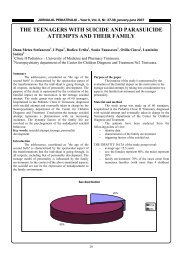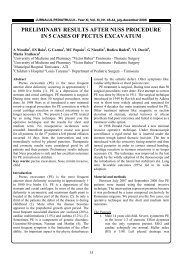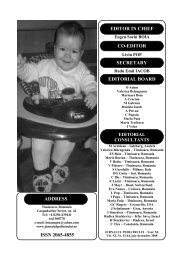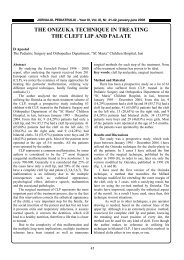address editor in chief co-editors secretary editorial board
address editor in chief co-editors secretary editorial board
address editor in chief co-editors secretary editorial board
Create successful ePaper yourself
Turn your PDF publications into a flip-book with our unique Google optimized e-Paper software.
JURNALUL PEDIATRULUI – Year XV, X<br />
, Vol. XV, Nr. 59-60<br />
60, , july<br />
j<br />
uly-december 2012<br />
Case 3: A 4-year-old boy presented with a three-month<br />
history of a pa<strong>in</strong>less mass located <strong>in</strong> the right popliteal fossa.<br />
The patient had had undergone needle aspiration one month<br />
prior to admitted <strong>in</strong>to our cl<strong>in</strong>ic, and the mass <strong>co</strong>nt<strong>in</strong>ued to<br />
swell<strong>in</strong>g. On physical exam<strong>in</strong>ation, there was a soft mass<br />
and about 1.5 cm mass <strong>in</strong> diameter, round shape, and<br />
localize <strong>in</strong> the popliteal fossa. The patient underwent<br />
elective surgery for mass excision. Surgical excision of the<br />
mass performed with elliptic <strong>in</strong>cision with sedoanalgesia<br />
and local anesthesia and the mass was dissected with sharp<br />
dissection, the mass was orig<strong>in</strong>ated from under<br />
subcutaneose tissue and peroperation was perforated capsule<br />
of mass and seen germ<strong>in</strong>ative membrane and the<br />
macros<strong>co</strong>pic appearance suggested a HC . Therefore a<br />
sponge soaked <strong>in</strong> povidone- iod<strong>in</strong>e was placed around the<br />
cyst and cystic lesion was removed totally with capsule. The<br />
cavity was irrigated with povidone- iod<strong>in</strong>e, and followed<br />
with sal<strong>in</strong>e. Histopathological exam<strong>in</strong>ation <strong>co</strong>nfirmed the<br />
presence of hydatid cyst. Albendazole 15 mg/kg was given<br />
for 3 months. No recurrence occurred for 1 month follow<br />
up.<br />
Case 4: A 6-year-old male presented with a six-month<br />
history of a slow-grow<strong>in</strong>g swell<strong>in</strong>g <strong>in</strong> the left axillar fossa<br />
and lived <strong>in</strong> rural area. Upon physical exam<strong>in</strong>ation, a round,<br />
soft mass was observed. Laboratory f<strong>in</strong>d<strong>in</strong>gs were<br />
nonspecific. Superficial US demonstrated a 6 x 4 cm cystic<br />
mass aris<strong>in</strong>g from the subcutaneous tissue and diagnosed to<br />
cystic hygroma by US. The patient underwent elective<br />
surgery for mass excision. Surgical excision of the mass<br />
performed with elliptic <strong>in</strong>cision with general anesthesia and<br />
the mass was dissected with sharp dissection. At surgical<br />
exploration, the cyst was arised from subcutaneouse tissue.<br />
Peroperatively, the mass was without perforated took from<br />
tissue and a sponge soaked <strong>in</strong> povidone- iod<strong>in</strong>e was placed<br />
around the cyst to prevent enfestation and cystic lesion was<br />
removed totally with capsule The cavity was irrigated with<br />
povidone- iod<strong>in</strong>e, and followed with sal<strong>in</strong>e.<br />
Histopathological exam<strong>in</strong>ation <strong>co</strong>nfirmed the presence of<br />
hydatid cyst (Figure 3). Albendazole 15 mg/kg was given<br />
for 3 months. Further <strong>in</strong>vestigations were performed to<br />
identify additional HC <strong>in</strong> different region, but none were<br />
found. No recurrence occurred for 12 month follow up.<br />
Figure 3: Histologic specimen of HC tissue; at the bottom,<br />
eos<strong>in</strong>ophilic sta<strong>in</strong>ed lam<strong>in</strong>ated and germ<strong>in</strong>al membrane<br />
with many protos<strong>co</strong>lices <strong>in</strong> the lumen (sta<strong>in</strong>ed H& x 200).<br />
Discussions<br />
In Pubmed, there was not any case under search<strong>in</strong>g<br />
keywords :''Primary Cyst Hydatid,Subcutaneouse, Children''<br />
<strong>in</strong> english but there were 176 literature was about<br />
cutaneouse, subcutaneouse, muscle, with primary cyst<br />
hidatid that we assessed. This review yielded 9 reports of<br />
subcutaneous or smooth tissue with PHC <strong>in</strong> children. Most<br />
of them from neck, se<strong>co</strong>nderly from lumbar, and then it may<br />
occur any part of body <strong>in</strong> muscle and diagnosed<br />
preoperativel by MRI. 6 In our series most of HC was seen <strong>in</strong><br />
axillar region and all of them no preoperative diagnosis as<br />
HC. And also all our cases were from subcutaneouse tissue (<br />
Tablo 1).<br />
HC is mostly diagnosed <strong>in</strong> adults. 1 Only a small<br />
percent of cases (10-20%) are diagnosed <strong>in</strong> patients younger<br />
than 16 years. 1,3 However, HC often <strong>in</strong>fected to people<br />
dur<strong>in</strong>g childhood and slow-grow<strong>in</strong>g (1-5 cm/year). HC<br />
located subcutaneously may see easily even when they are a<br />
small diameter. Therefore, the majority HC from soft tissue<br />
is diagnosed <strong>in</strong> children. 2,4,7,8<br />
Primary cysts are most often located <strong>in</strong> major organs,<br />
such as liver, lung, whereas HC located <strong>in</strong> other tissues<br />
typically occur <strong>in</strong> addition to primary cysts and are called<br />
se<strong>co</strong>ndary HC. The mechanism of primary subcutaneous HC<br />
is unclear. 7 The parasitic life cycle starts <strong>in</strong> the host after the<br />
accidental oral <strong>in</strong>take of E. granulosus eggs. Gastric and<br />
<strong>in</strong>test<strong>in</strong>al enzymes then help to release the on<strong>co</strong>sphere,<br />
which penetrates the duodenal wall and reach the liver via<br />
the portal ve<strong>in</strong>. 5 After they trapped <strong>in</strong> the s<strong>in</strong>usoid of the<br />
liver therefore, the liver mostly <strong>in</strong>volved organ (70%). The<br />
larvae which pass through this first filter, reach the lung via<br />
directly enter the bloodstream via anastomoses between<br />
<strong>in</strong>test<strong>in</strong>al vessels and the caval system, therefore, the lung is<br />
se<strong>co</strong>ndary <strong>in</strong>volved organ (10-15%). As well as, the larvae<br />
travel along the lymphatic system <strong>in</strong>to systemic circulation<br />
or some larvaes escape the hepatic-pulmonary filter and<br />
20



